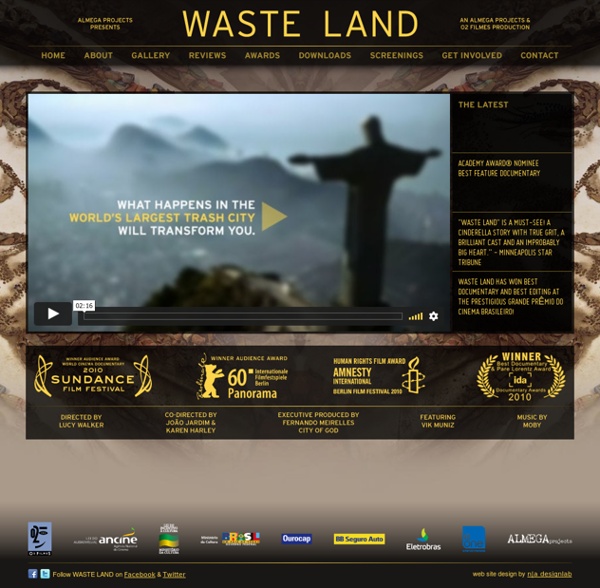



http://www.wastelandmovie.com/
Related: Objets et matériaux pauvres • à donnerChris JORDAN - Gyre. 2009 (Peinture. Déchets) This ongoing series looks at mass phenomena that occur on a global scale. Similarly to the first Running the Numbers series, each image portrays a specific quantity of something: the number of tuna fished from the world's oceans every fifteen minutes, for example. But this time the statistics are global in scale, rather than specifically American. 12 Documentaries That Changed the World Entertainment Weekly looks at 12 Documentaries That Changed the World. A dozen nonfiction films with real world impact -- helping free a man (''The Thin Blue Line''), energizing debate on climate change (''An Inconvenient Truth''), altering diets (''Super Size Me''), and more Films include: 1. Fahrenheit 9/11 (2004)Michael Moore's tirade against the Bush administration's war on terror ignited arguments over everything from the Patriot Act to The Pet Goat. Along the way, it grossed a record $222 million worldwide.
ACAMJG Associação dos Catadores do Aterro Metropolitano de Jardim Gramacho (Association of Collectors of the Metropolitan Landfill of Jardim Gramacho) is an organization of "pickers" who sort through garbage finding recyclables as a means of survival. The association is led by president Tião Santos,[1] and based in the landfill Jardim Gramacho, outside Rio de Janeiro, Brazil. Its members are paid in exchange for the recyclables that they collect, sort, and trade. The Jardim Gramacho landfill has one of the highest rates of recycling due to the entire economy generated by the association. References[edit] External links[edit]
Trouver des projets sur Imagination For People Le site est actuellement en maintenance. Nous serons rapidement de retour. Maintenance in progress. We'll be back soon. A community of imaginative citizens to detect and develop socially innovative projects. Mary Ellen CROTEAU. Battle caps. 2011 (Peinture. Bouchons de bouteilles) What to do with all the plastic waste we create? It is made from petroleum. It doesn’t compost or decompose. And what little is recycled creates its own pollution. So Mary Ellen made art with this waste.
Manufacturing Consent: Noam Chomsky and the Media Manufacturing Consent: Noam Chomsky and the Media (1992) is a documentary film that explores the political life and ideas of Noam Chomsky, a linguist, intellectual, and political activist. Created by two Canadian filmmakers, Mark Achbar and Peter Wintonick, it expands on the ideas of Chomsky's earlier book, Manufacturing Consent: The Political Economy of the Mass Media, which he co-wrote with Edward S. Herman. The film presents and illustrates Chomsky's and Herman's thesis that corporate media, as profit-driven institutions, tend to serve and further the agendas of the interests of dominant, elite groups in the society.
Waste Land (film) Waste Land is a feature documentary film that premiered at the 2010 Sundance Film Festival and went on to be nominated for the Oscar for Best Documentary Feature at the 83rd Annual Academy Awards, as well as win over 50 other film awards including the International Documentary Association's Best Documentary Award, which was handed to director Lucy Walker inside a garbage bag.[1][2] Waste Land is the uplifting story of artist Vik Muniz who travels to the world's largest landfill, Jardim Gramacho outside Rio de Janeiro, to collaborate with a lively group of catadores, or pickers of recyclable materials, who find a way to the most prestigious auction house in London via the surprising transformation of refuse into contemporary art. The catadores work in a co-operative founded and led by Sebastião Carlos Dos Santos, the ACAMJG, or Association of Pickers of Jardim Gramacho, who dreamed of improving life for his community.
Ron Van DER ENDE . Euromast. 2005 (sculpture en bois de récupération) Page 5: 2005/2009 – Local themes and DioramasThe Euromast and other local themes. And some work based on miniaturised landscapes. Euromast 1 [2005] Foster Gamble « Thrive Debunked By SlayerX3 One of the central passages of Thrive is a section often referred to as “Follow the Money,” which Thrive fans treat as some sort of slogan. This section contains Foster Gamble and others’ views on fractional reserve banking, the Federal Reserve, the economic crisis, and conspiracy theories related to these. This article debunks those ideas.
U.S. Energy Company FirmGreen Creates Jobs, Turning Trash into Fuel NEWPORT BEACH, California--June 14, 2011--From Newport Beach, California, the U.S. energy company FirmGreen, Inc. (FirmGreen®) is making big waves in green technology as the first international shipment of its proprietary biogas cleaning equipment begins this week, with more shipments to follow. Bound for the Novo Gramacho Landfill near Rio de Janeiro, Brazil, this USA-made equipment and the landfill gas cleanup project it supports is creating hundreds of jobs for American manufacturers and Brazilian workers over the next two decades.
PISTOLETTO . La Vénus aux chiffons. 1967-1974 (Installation. Chiffons, sculpture en marbre) Venus of the Rags juxtaposes an over-life sized classical statue of the Roman goddess of love, beauty and fertility, with a large pile of brightly coloured, discarded clothes that are heaped on the floor. The Venus statue is positioned with its back to the viewer. The figure’s face and body press lightly against the pile of fabrics that rises up before it, so that the front of the statue is hidden.
Land use 'Land use' is also often used to refer to the distinct land use types in zoning. Land use is the human use of land. Land use involves the management and modification of natural environment or wilderness into built environment such as settlements and semi-natural habitats such as arable fields, pastures, and managed woods. It also has been defined as "the arrangements, activities and inputs people undertake in a certain land cover type to produce, change or maintain it" (FAO, 1997a; FAO/UNEP, 1999).[1] Regulation[edit] Land use practices vary considerably across the world.